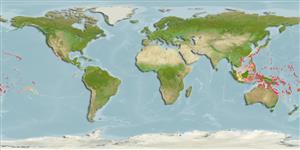Actinopyga palauensis Panning, 1944
Panning's blackfish| Native range | All suitable habitat | Point map | Year 2050 |

|
| This map was computer-generated and has not yet been reviewed. |
| Actinopyga palauensis AquaMaps Data sources: GBIF OBIS |
Classification / Names Common names | Synonyms | CoL | ITIS | WoRMS
Holothuroidea | Holothuriida | Holothuriidae
Environment: milieu / climate zone / depth range / distribution range Ecology
Reef-associated; depth range 0 - 25 m (Ref. 122), usually 5 - 15 m (Ref. 104244). Tropical
Distribution Countries | FAO areas | Ecosystems | Occurrences | Introductions
Pacific Ocean.
Length at first maturity / Size / Weight / Age
Maturity: Lm ? range ? - ? cm Max length : 40.0 cm TL male/unsexed; (Ref. 122); common length : 30.0 cm TL male/unsexed; (Ref. 122); max. published weight: 500.00 g (Ref. 122); max. reported age: 6 years (Ref. 104241)
Short description Morphology
Body-wall thickness: 0.6 cm (Ref. 122). Color: blackish-brown (appearing black at depth) over entire body, dorsal surface textured, anus terminal, papillae sparse and short, anal teeth nodulous or serrated (Ref. 104244).
A poorly known species. Collected by divers for artisanal fisheries, but not intensively so, as it is found in lower densities and has a deeper distribution than other "blackfish" species. Processed product is not distinguished from those of other Actinopyga species; moderate commercial value. Occurs in moderately shallow water; never found on reef flats, but on flagstones of reef slopes (Ref. 122), particularly on sand on fore reef slopes (Ref. 85218). On coarse sand with coral rubble. Also found on semi-sheltered bay reefs with boulders and coral rubble; seldom on lagoon reefs or inshore reefs (Ref. 92930). Populations reach medium densities up to 0.1 per square meter. A poorly known species (Ref. 122).
Life cycle and mating behavior Maturity | Reproduction | Spawning | Eggs | Fecundity | Larvae
Main reference
References | Coordinator | Collaborators
Conand, C. 1998. (Ref. 122)
IUCN Red List Status
(Ref. 130435: Version 2024-2)
Least Concern (LC) ; Date assessed: 18 May 2010
CITES status (Ref. 108899)
Not Evaluated
CMS (Ref. 116361)
Not Evaluated
Threat to humans
Harmless
Human uses
Fisheries: commercial
| FishSource |
Tools
More information
Trophic Ecology
Food items
Diet composition
Food consumption
Food rations
Predators
Diet composition
Food consumption
Food rations
Predators
Ecology
Population dynamics
Growth
Max. ages / sizes
Length-weight rel.
Length-length rel.
Length-frequencies
Mass conversion
Recruitment
Abundance
Max. ages / sizes
Length-weight rel.
Length-length rel.
Length-frequencies
Mass conversion
Recruitment
Abundance
Life cycle
Distribution
Human Related
Aquaculture profiles
Stamps, coins, misc.
Stamps, coins, misc.
Outreach
References
Internet sources
BHL | BOLD Systems | CISTI | DiscoverLife | FAO(Publication : search) | Fishipedia | GenBank (genome, nucleotide) | GloBI | Gomexsi | Google Books | Google Scholar | Google | PubMed | Tree of Life | Wikipedia (Go, Search) | Zoological Record
Estimates based on models
Preferred temperature
(Ref. 115969): 24.6 - 29.3, mean 28.3 (based on 1648 cells).
Price category
(Ref. 80766):
Unknown.



